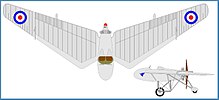Westland-Hill pterodactyl
Westland-Hill Pterodactyl was the name derived from the pterosaur Pterodactylus for a series of British experimental aircraft whose development began in the 1920s.
history
The unusual concept was developed by Geoffrey TR Hill and the planes were built by Westland Aircraft . The first examples were tailless shoulder or high- wing aircraft with fully movable wing tips for control, with which one wanted to eliminate the problem of stalling and spinning. Later, fighter and transport aircraft were also in development.
The constructions are said to have been inspired by watching seagulls . When the two movable wing tips were moved in the same direction, they worked as elevators , when they were moved in opposite directions, they worked as ailerons . On the Pterodactyl V, the wing above was braced against a wing stub below, creating the appearance of a one -and- a -half -wing aircraft .
variants
- Pterodactyl I with rotatable wing tips
- Pterodactyl IA with rotatable wing tips
- Motor Bristol Cherub
- Pterodactyl IB with rotating wing tips
- Engine Armstrong Siddeley Genet
- Two-seater Pterodactyl IV with closed cockpit and normal control flaps
- Pterodactyl V: Fighter aircraft with a 600 hp Rolls-Royce Goshawk engine, two Vickers machine guns and normal control flaps
Not built projects:
- Pterodactyl VI
- Two-seater fighter according to the Air Ministry Specification F.5 / 33 with a thrust propeller and a movable weapon turret in the nose tip.
- Pterodactyl Mk VII
- Flying boat with two pull and two push propellers, based on the R1 / 33 specification.
- Short Brothers- Hill Pterodactyl VIII
- Flying wing design with five pusher propellers driven by Rolls-Royce Griffon engines as a transatlantic passenger aircraft.
The Pterodactyl IA from 1925 is now in the London Science Museum .
Web links
- Unusual aircraft ( Memento of December 17, 2007 in the Internet Archive ) December 17, 2007
- Models of brushless British experimental aircraft
- Video flight recordings
literature
- Derek James: Westland-Hill Pterodactyls - Database . In: Airplane Monthly September 2010, pp. 59–73





